
Mecodema is a genus of large flightless ground beetle (Carabidae) endemic to New Zealand. The genus is very diverse in comparison to the other three New Zealand genera within the subtribe Nothobroscina. Mecodema is geographically widespread across both the North and South Islands, as well as numerous offshore islands, including the Three Kings Is., Poor Knights Is., Aotea and Hauturu, Kapiti Is., Stephens Is., Stewart Is., Chatham Is., Snares Is.

Mecodema oconnori is a large-bodied species of ground beetle that is found mainly on the western regions of the North Island, New Zealand. It is mainly found in native forest habitats, both intact and fragmented, and on the edges of pine plantations. Mecodema oconnori ranges from Otaki, Kapiti Coast to Raglan, but is also found in the Manawatu Gorge and some other eastern localities.

Mecodema haunoho is the only ground beetle (Carabidae) species that is endemic to Little Barrier Island (Hauturu). It is sister species of the Great Barrier Island (Aotea) species M. aoteanoho and both are closely related to M. manaia, a species found in Bream Head, Northland, New Zealand.
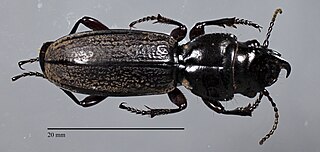
Mecodema chaiup is a large-bodied ground beetle species found in Mohi Bush Scenic Reserve, Hawke's Bay, New Zealand. A single specimen was found beneath a large log in 2008 by D.S. Seldon and C.P. Martin. Since then a number of intensive pitfall trap surveys of Mohi Bush have failed to collect further specimens.

Mecodema kokoromatua is a medium-bodied ground beetle endemic to Northland, New Zealand. Its range is restricted to coastal forest behind the sand dunes and below the southern areas of the Ahipara Escarpment, Herekino, Northland, New Zealand. This species is within the curvidens species group and is related to the geographically widespread M. parataiko.
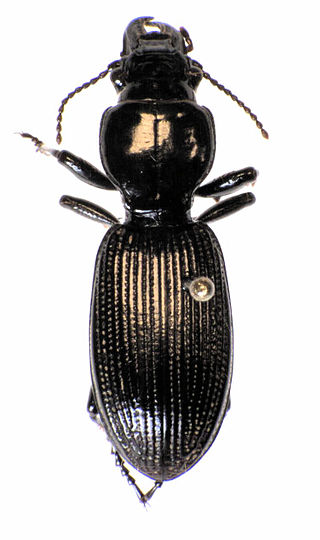
Mecodema manaia is a medium-sized ground beetle species found in the native forests of Bream Head and Mt Manaia, Northland, New Zealand. This species shares the forests of Bream Head with a large-bodied species, Mecodema tewhara, with both inhabiting slightly different forest type.
Mecodema atuanui was described from a single male specimen collected in pitfall traps on Mount Auckland (Atuanui), Kaipara Region. It is a medium-length ground beetle that is related to Mecodema spiniferum, which is the only large-lengthed ground beetle species found in the Waitākere Ranges, Auckland, rather than the more geographically close species to the east in Puhoi.
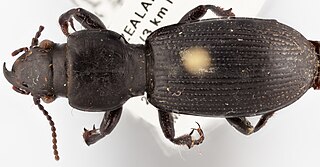
Mecodema atrox is a medium-sized ground beetle species that is closely related to Mecodema curvidens. Mecodema atrox is relatively rare in comparison due to its preferred habitat, the coastal broadleaf forests of the Coromandel Peninsula, a forest type that is in decline. The body of Mecodema atrox is black and the legs are dark reddish-brown. They can be distinguished from other Mecodema species by a number of characters, including the pattern of asetose punctures along the elytral striae.
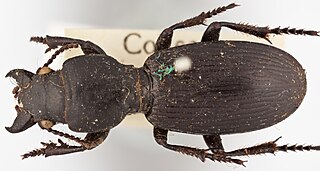
Mecodema curvidens Broun is a medium-bodied ground beetle that is geographically widespread throughout the central areas of the North Island, New Zealand, which includes the entomological regions of Auckland (AK), Waikato (WO), Coromandel (CL), Bay of Plenty (BP), Taupo (TO), Rangitikei (RI), Whanganui (WI), Hawkes Bay (HB) and Wellington (WN). Recently, the species M. occiputale Broun was synonymised under M. curvidens. Mecodema curvidens is relatively common through its range except in the southern area of the Hunua Ranges (Auckland) and Wellington regions.

Mecodema dux is a medium-bodied New Zealand endemic ground beetle that is found in the Ruahine Ranges, Taupo, Rangitikei and southwestern Hawke's Bay entomological regions.

Mecodema florae is an endemic New Zealand ground beetle, which was described by Britton in 1949. It is one of the few species within the genus Mecodema that has a range that includes both the North and South Islands. In the North Island it is found from Mt Taranaki (west) to Boundary Stream Mainland Island then southwards from the Taupo Line to Buller, northwest Nelson, South Island. Mecodema florae shares this range with its sister taxon M. longicolle, which is relatively similar in external morphology, but the male genitalia are different.
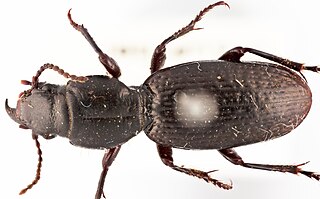
Mecodema longicolle is an endemic New Zealand ground beetle, and one of the few Mecodema species found in both the North Island and South Island.

Mecodema genesispotini is a species of ground beetle found in a small native forest remnant, between paddocks and pine forest, in the Waimata Valley, northwest of Gisborne, New Zealand.

Mecodema kipjac is a large-bodied ground beetle species found near Kirikopuni in Northland, New Zealand.
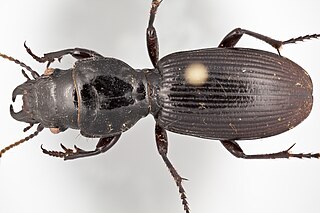
Mecodema kokoroiho is a large-bodied ground beetle that is endemic to Warawara Forest Park, Pawarenga, Northland, New Zealand. The species name (etymology) was provided by Te Rarawa kaumātua Joseph Cooper, Waipuna marae, Panguru, Northland. The specific name kokoroiho means ‘a beetle found with the fern root’.

Mecodema jacinda is a large-bodied ground beetle endemic to Maungatautari Sanctuary, Waikato, New Zealand. It is the largest species of Mecodema found on Maungatautari, which also has the medium-sized M. curvidens inhabiting the forest. It is named after former New Zealand Prime Minister Jacinda Ardern.
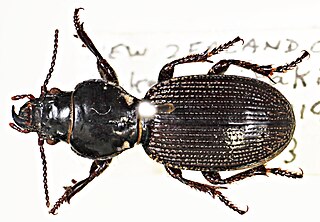
Mecodema aberrans is a medium-sized ground beetle endemic to the South Island, New Zealand. This species is within the curvidens group and is one of three species that is a braided-river ecotype. It occurs in Otago and Canterbury.
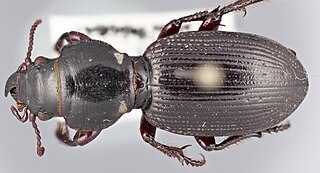
Mecodema moniliferum is a medium-sized ground beetle endemic to the South island, New Zealand. This species is part of the monophyletic curvidens group and is found on the braided-river systems of the South Island.

Mecodema crenicolle is an endemic species of ground beetle from New Zealand.

Mecodema scitulum is a species of endemic New Zealand flightless beetle in the family Carabidae. It was first described by Thomas Broun, in 1984, from a single specimen that he received from the Edwin Mitchelson. This species then became a junior synonym of Mecodema spiniferum after Everard B. Britton completed his revision of the New Zealand Broscini in 1949. Like Broun, Britton based this synonymy on the only specimen available, the holotype, because of the confusion surrounding the type locality where M. scitulum was collected from. However, D.S. Seldon and T.R. Buckley (2019) reinstated the species M. scitulum based on the morphological comparisons of 30+ specimens with the holotype and molecular analyses.



















